COVER- Snowpocalypse: Storm of the new century and what went wrong
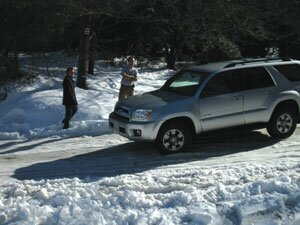
Jack Dougherty, left, and a friend watch a car negotiate an all-white curve on Ivy Depot Road on Sunday, December 27– more than a week after the snow stopped falling.
PHOTO BY HAWES SPENCER
If you were not already safe at home around 5pm December 18, odds are pretty good you were stuck in traffic somewhere– or stuck in a ditch.
The worst snowstorm to hit the record books in December— 20.5 inches officially, but routinely described as two feet—paralyzed the region in the days leading up to Christmas.
Route 53 past Monticello and U.S. 29 south would be closed for more than 24 hours. But also practically impassable were Route 20 south and U.S. 29 north, U.S. 250 west, and just about any major artery in the region.
Harder to understand is why, one week after the snow stopped falling and four days after the Virginia Department of Transportation said all secondary roads had been cleared, Ivy Depot Road resident Jack Dougherty had yet to see a plow on his road or nearby Morgantown Road.
"I'm like Mrs. Kravitz on Bewitched," says the public affairs consultant who works from home on Sunday, December 27. "I see the trains and the cars go by. Not one plow."
For over a week, Dougherty had to spend an hour making what is normally a ten-minute round-trip to take his two- and five-year-old girls to the daycare center just a couple of miles from his house. Indeed, on the day he meets with a reporter, Ivy Depot Road, an extension of Dick Woods Road, is still all-white at the bend outside his home. Even where some asphalt is visible a few hundred yards away, driving it can be like negotiating wagon tracks–- that weren't made for your wagon.
"This is the principal artery down to [Interstate] 64 from Ivy and Crozet," says Dougherty. "It's been nine days, and we have seen one [plow] yet."
Ever since 1997, when Sebastian Junger wrote a popular book about a deadly nor'easter, there's been a term that's practically become a cliché for that rare combination of circumstances in which all factors line up to create a catastrophe. Indeed, responders to the nearly two feet snow repeatedly called it "a perfect storm."
It's human nature to ask what happened, to ask why utter gridlock should strike– and why it should stay. Why should the main north-south thoroughfare close and stay closed for over 24 hours? Surely, someone did something that contributed to the meteorological mess.
Here, to our dismay, we found another cliché, this time from Pogo: We have met the enemy, and he is us.
'I've never seen anything like it'
Even in good weather, the mountainous terrain of U.S. 29 south toward Lynchburg poses a challenge. On Friday, December 18, it proved disastrous.
"I have never seen it so bad, and I've been driving for 35 years," says East Tennessee-based truck driver David Rutherford, who entered Albemarle County just before the squall began.
"I've been in blizzards in Minnesota and New York," says Rutherford. "In about 45 minutes, there were two to three inches on the ground."
A driver with Harris Trucking, which is based in Madison Heights, just north of Lynchburg, Rutherford was heading that way. And in southern Albemarle, things began to get especially tricky past the Cove Presbyterian Church in Covesville.
"That road is so hilly and curvy," says Rutherford. "If you're in a truck and get stopped on a hill in a curve, you're going to start sliding sideways. People would get halfway up the hill and spin out, then slide into a ditch."
He estimates he saw about six to eight 18-wheelers that had jackknifed. Far worse, Rutherford contends, were the four-wheeled drivers.
"The cars caused the biggest wrecks on 29," he says. "There's always a couple of lamebrains who have four-wheel drive and SUVs who think they can pull out and pass everybody. When you get on ice, I don't care what you're driving.
"Finally, people got wise and followed me and another fellow [trucker] in our tracks, instead of passing," says Rutherford.
It took Rutherford more than three hours to get from I-64 to Colleen, a tiny Nelson County crossroads about five miles south of Lovingston. By that point, it was 6:45pm; and Virginia State Police told him that he was going to be camped out for the night.
"I'd already made up my mind I couldn't go too much further," says Rutherford, who pulled over and parked on the side of the road. He was one of the lucky ones.
Rutherford has high praise for the state troopers who kept checking on him and fellow truckers to make sure that they had plenty of water and food, and for the Virginia Department of Transportation workers who, around 6:30am Saturday, cleared a lane for him to get past another truck blocking the road.
"It's the worst storm I've seen," says Rutherford. "I've seen snow that deep, but never one that fast, that quick."
Center of the storm
Marge Thomas has seen bad weather in her job as emergency management coordinator for the region's Emergency Communications Center.
Her uh-oh moment came on Thursday, December 17, during a conference call. The Virginia Emergency Operations Center was on the line with responders from several jurisdictions and the Sterling office of the National Weather Service.
"Sterling said we'd be hardest hit," she recalls. "They said we were in this pocket, and it could be 20 inches. That was a surprise. 'We're not getting off the hook. We need to be prepared to open our own EOC.'"
Thomas went home Friday for a few hours until the Charlottesville Fire Department picked her up and returned her to the Center, from which she didn't leave again until noon Tuesday, December 22.
"Things were bad quickly, particularly in Albemarle County," says Thomas.
She praises how the three jurisdictions– Albemarle, Charlottesville, and the University of Virginia– worked together, along with other agencies.
"Chief [Timothy] Longo offered some of his officers in the urban ring," says Thomas of the Charlottesville Police chief.
By 3am Saturday, as it became clear that the stranded motorists weren't going anywhere, Thomas started making calls to set up shelters. The question was, where to put them.
"At first, we talked about Monticello High School," says Thomas. But there were concerns about the conditions of the roads getting to the school, as well as the distance from stranded cars.
"A university officer suggested the Aquatic Center," says Thomas. "It was a straight shot for those southern routes."
The Red Cross provided cots, and a fire department truck towed over a trailer full of them.
From 4pm Friday through Sunday night, the emergency center logged 4,550 calls, and dispatched fire, rescue and police personnel to 1,229 of those calls. Friday night, the Center was averaging 228 emergency calls an hour.
"The public safety people were swamped with calls," says Thomas. Heightening the frustration was that response times were slowed by the weather.
As evidence of the mayhem, Albemarle County began sending out urgent requests for members of the SUV-owning public to please volunteer to drive first responders.
"We had no control," Thomas notes.
Looking forward, looking back
Thomas says the emergency responders will debrief in the new year to see what worked– and didn't work.
"For something like this, I don't think you can be prepared enough," offers Thomas. "Science is only so accurate. There have been times we've been threatened with snow and nothing happened."
Still, the warnings were out there that one to two feet of snow were coming, says Thomas. "When you hear about this or a hurricane, you need to take personal responsibility," she admonishes.
"It seemed like there was adequate notice," echoes Albemarle spokeswoman Lee Catlin. "They were speaking one to two feet of snow for a couple of days in advance. This was not a dusting. People didn't seem to take it seriously. What kind of warning would people pay attention to? I think we've gotten lulled into complacency."
Catlin lists factors that contributed to the snowy gridlock on the county's major roads: Friday afternoon commuter traffic, Christmas shopping, and students leaving for or coming home.
"All the perfect storm elements," says Catlin. "It was just a huge amount of snow."
The longest Saturday
Deana Moyer lives in Pennsylvania, and when her truck driver boyfriend asked her to make a run with him to Altavista, Virginia, she agreed. They left Baltimore around 10pm Friday night, and by 8:30am Saturday, December 19, they'd come to a standstill on U.S. 29 south of I-64. The truckers communicated by CB radio through their long sojourn.
"No one answered when we asked why we were stopped," says Moyer.
U.S. 29 south was closed all that Saturday, according to Albemarle police Lieutenant Todd Hopwood, who says a press release went out to local media. And while he claims that flashing signs were eventually posted on the road north of I-64 to warn travelers that the route, which had been at a standstill since Friday night, was not an option, the sign arrived too late for Moyer.
And unlike the raves from David Rutherford farther south in Nelson County about how state troopers frequently checked on him through the night, Moyer says truckers in Albemarle got nothing.
"I kept watching," she says, "No one ever stopped at a truck. It only takes a second to say, 'Hey, you okay?'"
They'd remain there for almost an entire day.
She watched public safety officers remove stranded people from cars. But for the line of immobile 18-wheelers, "No one stopped, no one asked if we were okay," says Moyer, still angry four days after her ordeal.
"All we had with us," says Moyer, "were drinks– no food."
Unlike some of the stranded vehicles, the one carrying Moyer had plenty of diesel to keep the cab warm all day.
Through CB radio calls to other trapped truckers, Moyer realized she was the only woman in the queue, which posed a problem.
"I wish it would get dark," she recalls thinking. "I have to go to the bathroom."
Albemarle Fire/Rescue Chief Dan Eggleston estimates that rescue crews transported 150 people off the closed highways, and that there were between 75 and 85 trapped tractor-trailers.
"We tried to touch base at first," he says, "and if they said they were okay, then it could be 12 hours before we could go back to them."
Eggleston himself sat in traffic four hours Friday night trying to get home to Crozet, and once there, he turned around and headed back into town where he'd spend the next two days.
"I think the average person who was stuck was not as prepared as we'd like," says Eggleston. While he'd prefer that people simply stay home when there's word of bad weather, if they must venture out, he recommends bringing blankets, water, a charged cell phone, medications, and a shovel.
"We found we couldn't help everybody," says Eggleston. "A lot of people spent the night in their cars, and that put them at risk." Carbon monoxide was one danger, and a couple of people had symptoms of mild hypothermia.
"A lot of cars were totally covered in snow," says Eggleston. "We had to send people to check on them. That takes resources."
The North Garden Volunteer Fire Department took in about 50-60 people on Friday night, a large number for a station that size, according to Eggleston. And they took them back to their cars the next day. "That worked out well," he says.
"You end up making a lot of tough choices," he says. "People were calling to say they were running out of food. Our advice was to hang in there. We try to be compassionate, but we can't deliver food."
The National Guard contributed two Humvees and a large vehicle that could tow a firetruck. And that equipment helped get to areas that otherwise would have been unreachable.
"We were lucky we had no fatalities," says Eggleston.
With the storm hitting at commute time, "It created a perfect storm," says Eggleston. "This is a once-in-10-years storm."
By the time traffic finally started moving again around 7:30am Sunday, Deana Moyer had spent 23 hours stuck on U.S. 29 south. And once traffic started moving, the vehicles weren't allowed into Nelson, where the highway was closed for the first time since Hurricane Camille in 1969, according to Russ Simpson in Nelson.
Instead, they were sent to a crossover to turn around and head east to Richmond, without instructions on how to continue south, she says.
She wonders why drivers weren't warned about conditions on that road– and then were left to sit for so long. "Don't wait until it gets that bad," she says. "Stop traffic where there's food and water."
No wreckers in the arsenal
When a reporter with four-wheel-drive ventured out Saturday morning, he counted 55 abandoned vehicles between Ivy and the 29/250 Bypass. Public safety officials point to this as a contributing factor that made it harder to clear the roads during the storm and in the aftermath of a record snowfall.
"The main issue was abandoned vehicles," says Eggleston.
"If you have a tractor-trailer that's jack-knifed on 29 and it's left with a note, 'call me when the road is clear,' it's hard to move a tractor-trailer," says Todd Hopwood, Albemarle County police spokesman.
Things, he says, were "chaotic" amid the steady pleas for service and a lack of tow trucks.
"Snow can be moved," says Hopwood. "It's a lot harder to move vehicles."
Hopwood's predecessor in media relations, Captain John Teixeira, was working U.S. 29 south Friday night, and told Hopwood he'd never seen anything like that and estimated there were 300 cars immobile. "It was like a parking lot of cars," describes Hopwood.
"Over the weekend we left it alone because we didn't have wreckers," says Hopwood. Even Tuesday, December 22– four days after the storm started– an abandoned cab blocked a lane on two-lane U.S. 250 just west of Ivy.
December 22 was the day that police began clearing all vehicles that had tires on the asphalt, says Hopwood, and the towing charges are the owners' responsibility.
"Vehicles in a ditch, we're not messing with them," said Hopwood. The cars were tagged to indicate they'd been checked for occupants.
One such road-blocker covered with snow on U.S. 250 east at Shadwell inadvertently helped Hopwood find his keys. A county vehicle had been sent to pick him up Sunday—"I have a big pickup and that can't clear 24 inches," he says– and on the way back, they stopped to help a stuck car.
Once in the office, he discovered his keys were missing, and remembered getting out of the truck to help pull out the stuck car, and that an abandoned car partially blocked the road.
"I went back there about 11 that night," recalls Hopwood. "The entire stretch of 250 had been cleared except that one place where that car was in the lane and it hadn't been plowed. And I found my keys."
"I've been here 20 years, and I've never seen the number of abandoned cars," says Judith Mueller, Charlottesville's director of public works. "You have no idea how that hampers our ability to clear roads."
City streets 6 days later
At 6:34pm on Thursday, December 17, under the headline "City Prepared," the Charlottesville city manager's office issued a release:
"The City's Public Works and Parks and Recreation crews are ready for whatever falls from the sky."
Yet on Tuesday morning, December 22, at 7:49am, a Hook reporter took a photograph that showed Ivy Road near Emmet Street still snow-covered, something that provoked online howls from someone touting the superior snow procedures in Buffalo, New York. Mueller defends her department.
"We're not Buffalo," says Mueller. "We're not geared up for that, and I don't think taxpayers want to give me the money to stay geared up for that. This is a once-in-every-15-years storm. Our equipment works 99.99 percent of the time. We can't afford to cover the other .01 percent."
Albemarle County offices were shuttered on Monday; Charlottesville opened over two hours late. And, citing the traffic mess, UVA did the unthinkable. It canceled the Saturday night men's basketball game against UNC-Wilmington.
Critics wonder why city and VDOT plows took so long to start clearing. At 7:25pm Friday evening, when the storm was well underway, city spokesperson Ric Barrick said that plowing wouldn't begin until snowfall reached three inches.
"Normally, at two to three inches, we start plowing," says Mueller.
"Typically, we start at several inches— we don't want to push bare pavement," says VDOT spokesperson Lou Hatter.
Yet for many trapped on area roads that long night, no snowplows were spotted.
Mueller debunks a rumor that the city ran out of salt amid the storm.
"We were never close to running out," says Mueller. "At the beginning of the storm, we used all our resources to salt. That's paying off."
Even under snowpack, the salt forms a brine that ultimately makes the street easier to clear, Mueller explains.
She also denies that Hydraulic Road ever closed, something reported shortly before 10pm on Monday, December 21 by the Newsplex.
"The left turn lane got a little slick, and we closed the lane," explains Mueller. "We never closed the road."
City workers were vexed by tight clearances and deep snowpack.
"A pickup with a plow can't do 24 inches," says Mueller.
She even pulled out a nearly 40-year-old grader that hadn't been used since the 1996 storm.
"We stayed on the arterials until they were clear," says Mueller. "We kept plowing."
Still, by Tuesday, December 22, there had been three consecutive sunny days, yet many arterial roads had snow on them, and many city residents complained their smaller streets had yet to see a snow plow.
Worse for the public transit dependent, no buses were running except for the free trolley and Route 7 to Fashion Square Mall.
Was the city's performance a debacle?
"I have not heard one constructive suggestion from anyone on what we could do differently," she says. "I'm happy to listen."
The storm o' 1996
Lee Catlin was home with children during the third heaviest snowfall in local history: 21 inches January 7-8, 1996, the worst winter that most long-time residents remember and one that dumped another 14 inches less than a month later.
"I don't think things got cleared off any quicker then," says Catlin. "People have different expectations now that it's going to be cleared up quickly. In '96, we just hunkered down. My recollection is there's a sense this is a big snowstorm, and we're going to be immobilized."
One other big difference, she points out: "It wasn't the week before Christmas when people feel like they've got to get out."
"You can't compare storms," says Mueller. "It depends on how fast and how wet it is. It really is snow fighting. And this one was so fast and went going for 24 hours."
The 1996 storms did not close any major roads, according to Albemarle police recollections, says Lt. Hopwood, mentioning the department's snow-uncapable Dodge Ram truck.
"We struggled more then because we had fewer four-wheel drives," says Hopwood, who notes that the county has 15 now.
Hopwood describes the recent storm as like "the flick of a switch" in its rapidity and intensity. "I don't want to say it was a perfect storm," he says, "but it kind of was."
As for Monday-morning quarterbacking that's erupted all over, he says simply, "You can't plan for everything." Instead, he'd rather talk about the number of public safety employees who came in days on off to help, and how well different agencies worked together.
"This is Virginia," says Hopwood. "We don't usually get two feet of snow. Virginia does not have dual-blade plows. VDOT did a very good job."
As one might assume, VDOT has come under fire about the county roads that were uncleared for days after the snow, but by December 23, all secondary roads will have been scraped to some degree, says VDOT spokesman Lou Hatter, who clearly had not spoken to Jack Dougherty on unplowed Ivy Depot Road.
Calls to James S. Utterback, VDOT's boss of the Culpeper District, which serves Charlottesville and Albemarle were referred to Hatter.
"We will certainly do an after-action review on VDOT's response, and Route 29 will be part of that," says Hatter December 23. "Right now, we're still in the operations phase of the storm."
In Charlottesville, Mayor Dave Norris says he's not sure that a spending spree is the answer, particularly since he only heard a "handful" of complaints.
"If we were to purchase the amount of equipment and hire the amount of staff that we'd need to remove that much snow," says Norris, "we'd probably hear that we are over-prepared."
On Monday, January 4, the city's Mueller issued a post-storm report to City Council, and acknowledged several lessons learned. In future mega-snows, private contractors would be called in sooner to help with plowing, and the rubber-tipped blades used by the city to protect streets would be yanked off sooner– neither of which in this storm occurred until Monday, December 21, said Mueller.
"We need to get more information out to citizens through the media," added Mueller, including the message to stay home.
Councilor David Brown was concerned that buses didn't run for several days, and Mueller pointed the finger at Charlottesville Transit Service, which made the call to cancel service, and unplowed Albemarle County roads.
"The point is, it's so unsafe to walk in the street," said Brown, urging that public works make plowing bus routes a priority.
VDOT's Hatter would like to clear up one misperception that's swirled around: that state budget cuts slowed VDOT's response.
"Emergency response is our core mission," says Hatter. "The budget has not been affected for snow removal."
Outgoing Governor Tim Kaine disagrees, and in an interview with NBC29, says that budget cuts led to a smaller VDOT budget and limited resources.
He also criticized the contractor VDOT used to outsource plowing. "We were not completely satisfied with the work done by the contractor," he tells the television station. "Without going into it too much, on Saturday I basically asked VDOT to take over a good bit of that work."
Still, there are those odd situations like the closed thoroughfares and Ivy Depot Road.
"Behold," says Jack Dougherty on New Year's Eve. "Thirteen days after the snow storm, a plow is outside my house."
Next stop for him a car-repair shop, where he figures he'll have to spend $1,800 on a cracked rear axle and a new exhaust system, which was demolished after hitting an ice chunk "the size of Texas" on Ivy Depot Road.
For those who suspect with VDOT was lazy or incompetent, Hatter employs a maritime analogy. "We worked around the clock and had all hands on deck."
But in a perfect storm, that wasn't enough to keep this boat afloat.
– With additional reporting by Hawes Spencer
#
Friday
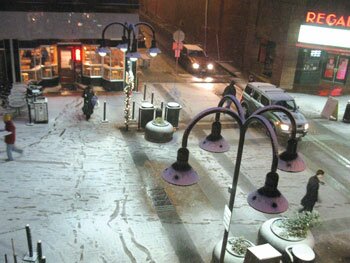
By 5:09pm, the snow which had begun falling 74 minutes earlier, had begun to accumulate on the Downtown Mall.
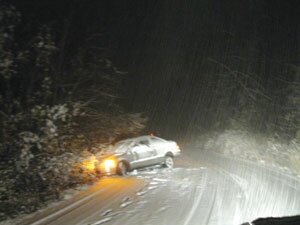
There were nine ditched cars on Dick Woods/Ivy Depot Road by 7pm Friday.
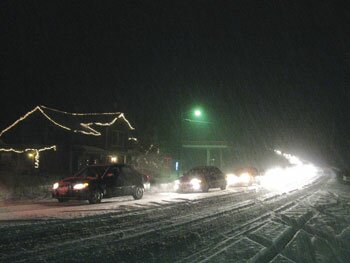
Anyone commuting west along Route 250 would creep for hours.
Saturday
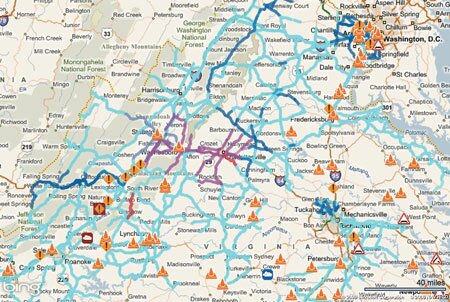
VDOT's road condition map of 8:54pm Sunday showed Albemarle and Augusta the worst.
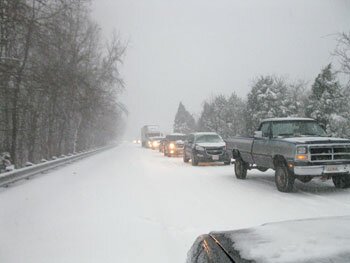
Like lambs to slaughter, these vehicles on U.S. 29 South were queuing up Saturday for about 24 hours of cold and hunger.

Jack-knifed trucks were in for a very long wait.
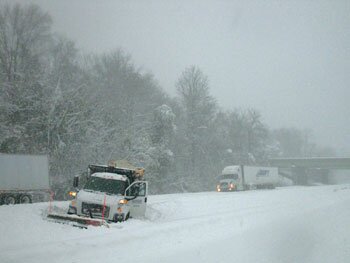
Even this VDOT plow got stuck Saturday on 29 near 64.
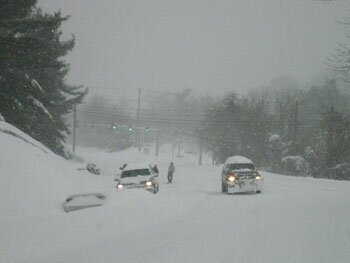
And Ivy Road near Ednam was a white-out.
Sunday
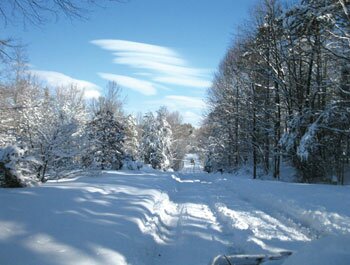
Vermont-like Owensville Road was blocked Sunday near Stowe Court by a stuck Dominion Virginia Power Truck, background.
Monday
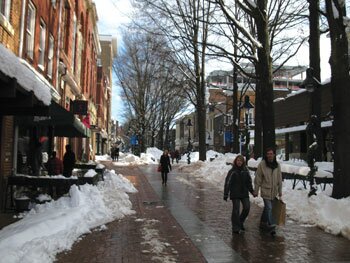
While the Downtown Mall was scraped clear by Monday...
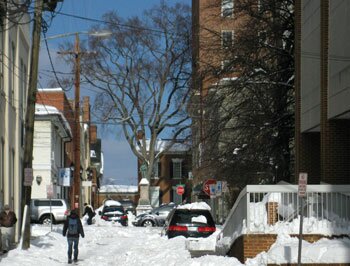
...many side streets such as Sixth Street remained unplowed.
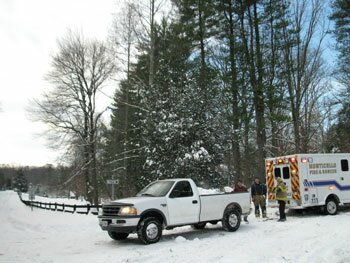
Monticello Fire Rescue got stuck on Dudley Mountain Road.
Misc

VDOT's Culpeper regional boss, James Utterback, directs approximately 515 employees and is responsible for approximately 10,250 miles of state-maintained roads in the nine-county region.
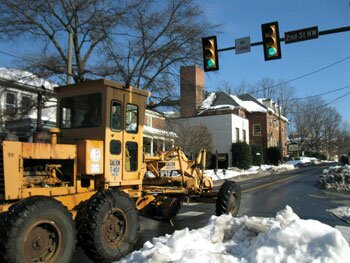
With many blade-equipped trucks overwhelmed by the depth, the city hauled out some heavy equipment.
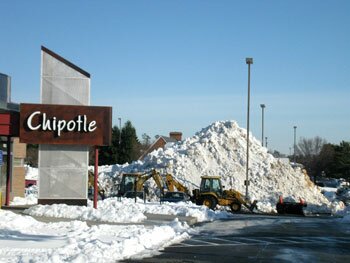
Barracks Road Shopping Center created a mountain near Chipotle.
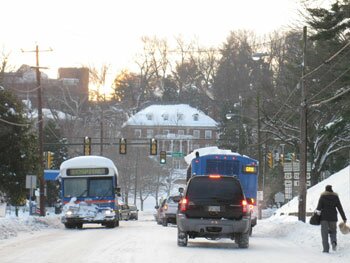
While University buses were running on Monday, the city's buses were reduced to two routes until a third was added back Wednesday.
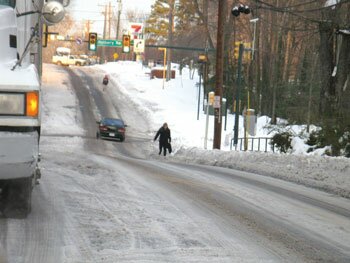
This Ivy Road photograph provoked online outrage since it was showed a still-snowy, still pedestrian-unfriendly Ivy Road on Tuesday morning.
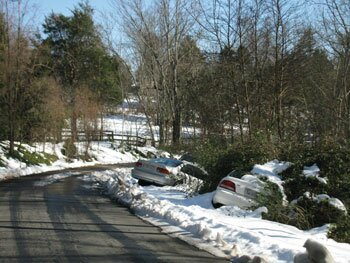
Two days after Christmas, these cars on Ivy Depot Road were still unclaimed.
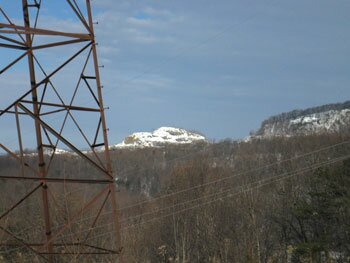
In Red Hill, Albemarle County's only mountain-top removal mine gained a snowcap.
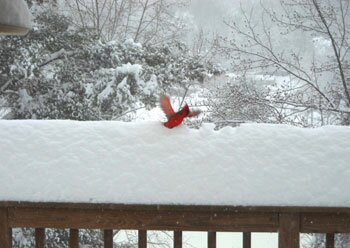
And a cardinal on a porch railing gained immortality.
PHOTO BY COY BAREFOOT
#

12 comments
"OMIT THIS ONE IF WE DO THE "BOTCHED COMMUTE" SIDEBAR"
"-OMIT IF WE RUN "BEAUTIFUL GRIDLOCK" SIDEBAR"
Might want to fix a coupla captions since it looks like you went with the crowd pleasing and sentimental "Kindness of strangers" sidebar...
Also, don't forget the "--OPTIONAL" on the immortal cardinal.
Our state bird optional? Have you no sense of patriotism?
I find it interesting that Barracks rd shopping center was down to pavement the next day but the city and county pictures are all still icy looking...
I would like to see an article about how they hire the private contractors. I have heard they demand outragoeus insurance requirementsa that keep people from signing up becuase they have to buy the expensive extra insurance and might not be called.
Was there some sort of bet going on about how many times can we say "perfect storm" in one article?
Very informative article with great photos. Thanks.
We live in far eastern Albemarle county, on route 22 - not exactly a major thoroughfare. Two days after the storm we had no problem driving all the way from our home on 22 and 250 until we hit the city limits. Then we hit packed snow and ice on 250, Emmet Street, Barracks Road, etc. Shocking our little country lane could be clear down to the payment and there was three inches of the stuff still on the major roads in the city. The amazing thing was that on Wednesday the 23rd, the situation in the city hadn't improved much. There was no evidence of plowing on Barracks, Emmet, etc - its like the city maintenance people didn't want to plow one more time - around the major shopping center in the city - two days before Christmas. Yet the parking lot was clear - except for the huge piles of snow. (Most cities dig out those piles and take them elsewhere.) Also, the city didn't seem to want to plow around the on street parking areas - leaving just narrow pathways when they could easily go back and plow again. I know this is a southern city, but it doesn't take much to plow again to get to pavement and widen things. That's what most cities do. I know it was the snow of the decade, but really - six days later, and you can't take a second pass on a major road?
Unlike Ms. Catlin, I had to get to work during the storm in 1/96 as well as train for a marathon I was running in 2/06. The roads were cleared and sanded. Since VDOT was compelled in 2006 by our legislature to outsource maintenance by 7/1/09 (Section 33.1-49.1) this is the first test of the outsourcing for snow removal. Outsourcing failed. The public safety was endangered. Call your state representatives. They're to blame.
The picture up the side street from the Mall is 5th Street, not 6th Street.
Today, weeks after the storm, there are still large piles of snow making both vehicular and pedestrian traffic in Charlottesville difficult in many spots, even major routes. The bus stops haven't even been cleaned properly. Yes, it was an unusually bad storm, but that was then. This is now. The response of the city has been incompetent.
Dan, were you expecting the City to defrost with a huge microwave, or did you have some other plan for melting the snow?
My husband and I were out in the snowtastrophe from 5 PM Fri until 1:30 AM Saturday, striving unsuccessfully to travel from AHS area to Keswick Hall, finally giving up and completing the loop back home. My observations that night were mixed. I think that most of the highway folks made a heroic effort, but the 13 inches of snow that dumped during that time, and starting at rush hour to boot, got the entire effort stuck behind the 8 ball. Any miscalculation became multiplied. It was what DIDN'T happen afterward that stunned me. It was Monday afternoon before Hydraulic Road saw a plow, and that one with the blade up. We had developed a 6- to 8-inch snow-pack base that could have been better managed with sand. The trucks that came through dropped salt, resulting in 6-8 inch deep "snowholes" that eventually became 6-8 inch deep "slush-ruts" by Monday evening. What seemed most astonishing was that as we moved around town during the runup to Christmas, we continued to see few plows and no daytime-melt clearing. I'm puzzled that it seemed as though nobody used Mother Nature's help to clear the roads during the warmth of sunny days, and especially during the the warmer rainy day. I smiled when I saw the guys making the Barracks Road snow mountain on Christmas night during the rain. Someone clearly understood that WET snow moves, ICE doesn't. If I had to critique the local effort, it would be because they didn't seem to know how to "make lanes while the sun shines"!